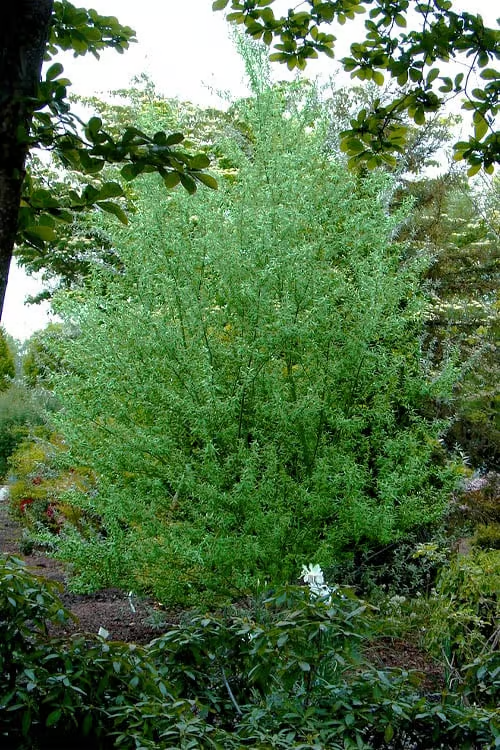
perennial plants
Fast-growing, provides quick privacy
Hardy in various soil conditions
Low maintenance, easy to care for
Thrives in
ZONE 5ZONE 6ZONE 7ZONE 8Planting Season:
Nov-AprilWhen you add one plant to cart, it automatically adds the second one free on Bogo deals.
Silky Willow is a deciduous shrub with silver-gray foliage and slender, flexible branches. It is often used for erosion control and habitat restoration. Due to its numerous benefits and aesthetic qualities, it is a valuable addition to landscaping projects. These versatile shrubs contribute to outdoor spaces' visual appeal, ecological health, and functional aspects.
It is a shrub that belongs to the Salicaceae tree family. It is genetically similar to tree variants like the poplar, aspen, and cottonwood. Because it is a shrub, it can grow to rather significant heights.
It additionally grows long and thin purplish branches. It grows long leaves that reach up to 10 centimeters in length. The leaves have hair near their tops and are dark green. The leaves are lighter green with white silk hairs on the underside, hence the name of this tree. It blooms in late May and grows leaves through the fall season.
People who want to add this type of tree to their commercial or residential properties often find it best to buy seedlings. Given how tall and wide this tree can grow, it can be difficult for people to handle when it is close to or full-grown. Rather than try to transplant a large tree, people often find it easier to plant seedlings from more giant trees of this variant. The seedlings are usually only a few feet tall, if not shorter. Once planted, the seedlings can proliferate and gain significant height during the first few years. The blooms on these trees typically mature in June. It is not uncommon for these types of trees to live for as long as 400 years.
People who choose this tree/shrub can enjoy numerous benefits from this type of tree on their properties. Primarily, it can stabilize the soil in a person’s lawn or garden. It can neutralize the pH levels and make the soil healthier for new and existing vegetation. Likewise, these trees prevent soil erosion, which can be vital when property owners want to avoid having to lay down new soil year after year. The trees can save property owners both time and money.
Where does it thrive and grow well
It adapts well in areas with moist soil; hence it majorly grows near streams, wetlands, and lowlands. It needs full sun to partial shade, and it does well on a range of soil types, provided that the soil is moist.
What is the best fertilizer for it
It generally does not require any further fertilization if the soil you have is fomented. In some instances, a slow-release, balanced fertilizer in spring is useful, especially in weak soil.
How long does it live
It has a relatively short life of thirty to fifty years, as most species. Nonetheless, it develops fast, which is preferred in landscaping or restoration work, with fast and explicit growth to produce instant coverage and habitat for wildlife.
What is the right time to water it
This plant thrives in damp earth; hence, watering should be done at intervals, particularly during a dry season or when planting it for the first time.
Is It a low-maintenance plant
Silky Willow is very easy to grow and establish with little amount of attentiveness given to it. Its water-logging tolerance and the fact that it can grow in most soil types with little human interference make it a favorite of gardeners and conservationists.

Bloom Season
Spring
Height at Maturity
Over 10 Feet
Care
Silky Dogwood thrives in well-drained soil and benefits from regular watering, especially during dry spells. Prune in winter or early spring to preserve shape and remove dead or damaged branches. Mulch near the ground to retain dampness and suppress weeds.
Plant Reproduction
Silky Willow spreads via root suckers and seed dispersal
Plant bare-root shrubs during the more excellent spring or fall months, from November through April. Dig a hole twice as wide as the root system and slightly more profound than its height. Position the shrub so that the top of the roots is level with the ground, and put back the soil dug over the roots. Apply a 2-3 inch layer of mulch around the base to retain moisture and suppress weeds, ensuring the mulch does not touch the shrub's stem. Water regularly, especially during the first year, to establish strong roots. Prune shrubs as needed to promote healthy growth. In the spring, fertilize with a balanced, slow-release fertilizer suited to the specific needs of the shrub.
Shipping date depends on the date displayed and chosen when you order from the product's page.
We only accept returns on plants verified dead. If you think your plants have died, we offer a 1 year warranty, please use use this File a Claim Link to verify dead plants and start with return warranty process.




Elegant Appearance:
Silky Willow boasts soft, silvery leaves that add a touch of sophistication to any landscape.
Fast Growth:
This willow grows quickly, providing rapid coverage and instant beauty in your garden.
Versatile Planting:
Adaptable to a range of soil types and conditions, making it a versatile choice for different garden settings.
Beautiful Foliage:
The unique texture of the willow’s foliage offers a distinctive and eye-catching look.
Caring Tips
Each box contains detailed care instructions and information about your product. But here's the basics.
Care Tips
Silky Dogwood thrives in well-drained soil and benefits from regular watering, especially during dry spells. Prune in winter or early spring to preserve shape and remove dead or damaged branches. Mulch near the ground to retain dampness and suppress weeds.
Light Requirements
Silky Willow thrives in full sun to partial shade. It prefers at least four hours of direct sunlight daily but can also tolerate some shade, making it versatile for various garden settings while ensuring vibrant foliage and flowering.
Hardy Planting Zones
5 • 6 • 7 • 8
How often should I water my plants?
How do I know if my plant is getting too much or too little sunlight?
What should I do to prepare my plants for winter?
What are the signs that my plant needs fertilizing?
How can I prevent pests from damaging my plants?
How do I choose the right plant for my climate zone?